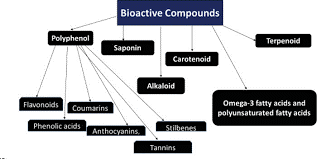
Mention Few Bioactive Compounds
The definition of “bioactive compound” knows dynamism, because the scientific research on the bioactivity potential is booming nowadays. Even if vague definitions and repeated use of the operative word “bioactive” almost integrated the term into a category of magic words, attempts to find a consensus and some common elements of the concept associated with the term “bioactive” did not stop, despite the fact that attempts to find a consensus and some common elements of the concept associated with the term “bioactive” did not stop. Glycosylated, esterified, thiolyated, or hydroxylated bioactive dietary components are commonly found in a variety of forms. Multiple metabolic activities of bioactive dietary components allow for positive effects in a variety of disorders and target tissues. Bioactive dietary components are assumed to be mostly contained in plant foods such as whole grains, fruits, and vegetables. Probiotics, conjugated linolenic acid, long-chain omega-3 polyunsaturated fatty acids, and bioactive peptides, on the other hand, are mostly present in animal products including milk, fermented milk products, and cold-water fish.

Source: ResearchGate.com
There are myriad bioactive food components in plant-based foods. Polyphenols, phytosterols, carotenoids, tocopherols, tocotrienols, organosulfur compounds such as isothiocyanates and diallyl-(di, tri)sulfide compounds, soluble and insoluble fibre, and fruto-ogliosaccharide are just a few examples. It’s more usual to find mixes of these substances in plant foods than it is to find a single class of bioactive food component.





